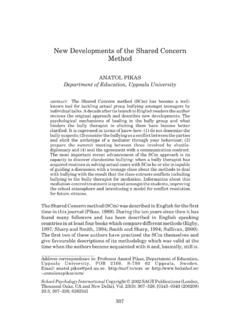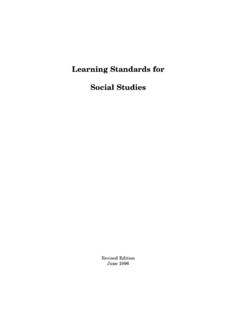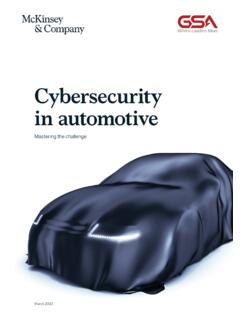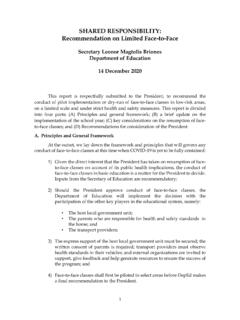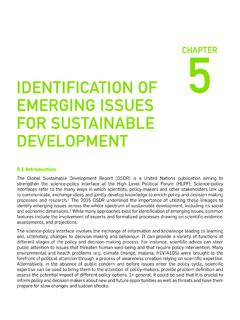Transcription of The Impact of Artificial Intelligence on Innovation
1 NBER WORKING PAPER SERIESTHE Impact OF Artificial Intelligence ON INNOVATIONIain M. CockburnRebecca HendersonScott SternWorking Paper 24449 BUREAU OF ECONOMIC RESEARCH1050 Massachusetts AvenueCambridge, MA 02138 March 2018 The authors would like to thank the organizers and participants at the first NBER conference on the Economics of Artificial Intelligence , and in particular our discussant Matthew Mitchell for many helpful suggestions and ideas. Michael Kearney provided extraordinary research assistance. The views expressed herein are those of the authors and do not necessarily reflect the views of the National Bureau of Economic Research.
2 Funding for this paper was provided by the MIT Sloan School of Management, by the HBS Division of Research and by the Questrom School of least one co-author has disclosed a financial relationship of potential relevance for this research. Further information is available online at working papers are circulated for discussion and comment purposes. They have not been peer-reviewed or been subject to the review by the NBER Board of Directors that accompanies official NBER publications. 2018 by Iain M.
3 Cockburn, Rebecca Henderson, and Scott Stern. All rights reserved. Short sections of text, not to exceed two paragraphs, may be quoted without explicit permission provided that full credit, including notice, is given to the Impact of Artificial Intelligence on InnovationIain M. Cockburn, Rebecca Henderson, and Scott SternNBER Working Paper No. 24449 March 2018 JEL No. L1 ABSTRACTA rtificial Intelligence may greatly increase the efficiency of the existing economy. But it may have an even larger Impact by serving as a new general-purpose method of invention that can reshape the nature of the Innovation process and the organization of R&D.
4 We distinguish between automation-oriented applications such as robotics and the potential for recent developments in deep learning to serve as a general-purpose method of invention, finding strong evidence of a shift in the importance of application-oriented learning research since 2009. We suggest that this is likely to lead to a significant substitution away from more routinized labor-intensive research towards research that takes advantage of the interplay between passively generated large datasets and enhanced prediction algorithms.
5 At the same time, the potential commercial rewards from mastering this mode of research are likely to usher in a period of racing, driven by powerful incentives for individual companies to acquire and control critical large datasets and application-specific algorithms. We suggest that policies which encourage transparency and sharing of core datasets across both public and private actors may be critical tools for stimulating research productivity and Innovation -oriented competition going M.
6 CockburnSchool of ManagementBoston University595 Commonwealth AveBoston, MA 02215and HendersonHeinz Professor of Environmental ManagementHarvard Business SchoolMorgan 445 Soldiers FieldBoston, MA 02163and SternMIT Sloan School of Management100 Main Street, E62-476 Cambridge, MA 02142and I. Introduction Rapid advances in the field of Artificial Intelligence have profound implications for the economy as well as society at large. These innovations have the potential to directly influence both the production and the characteristics of a wide range of products and services, with important implications for productivity, employment, and competition.
7 But, as important as these effects are likely to be, Artificial Intelligence also has the potential to change the Innovation process itself, with consequences that may be equally profound, and which may, over time, come to dominate the direct effect. Consider the case of Atomwise, a startup firm which is developing novel technology for identifying potential drug candidates (and insecticides) by using neural networks to predict the bioactivity of candidate molecules. The company reports that its deep convolutional neural networks far surpass the performance of conventional docking algorithms.
8 After appropriate training on vast quantities of data, the company s AtomNet product is described as being able to recognize foundational building blocks of organic chemistry, and is capable of generating highly accurate predictions of the outcomes of real-world physical experiments (Wallach et al., 2015). Such breakthroughs hold out the prospect of substantial improvements in the productivity of early stage drug screening. Of course, Atomwise s technology (and that of other companies leveraging Artificial Intelligence to advance drug discovery or medical diagnosis) is still at an early stage: though their initial results seem to be promising, no new drugs have actually come to market using these new approaches.
9 But whether or not Atomwise delivers fully on its promise, its technology is representative of the ongoing attempt to develop a new Innovation playbook , one that leverages large datasets and learning algorithms to engage in precise prediction of biological phenomena in order to guide design effective interventions. Atomwise, for example, is now deploying this approach to the discovery and development of new pesticides and agents for controlling crop diseases. Atomwise s example illustrates two of the ways in which advances in Artificial Intelligence have the potential to Impact Innovation .
10 First, though the origins of Artificial Intelligence are broadly in the field of computer science, and its early commercial applications have been in relatively narrow domains such as robotics, the learning algorithms that are now being developed 2 suggest that Artificial Intelligence may ultimately have applications across a very wide range. From the perspective of the economics of Innovation (among others, Bresnahan and Trajtenberg (1995)), there is an important distinction between the problem of providing Innovation incentives to develop technologies with a relatively narrow domain of application, such robots purpose-built for narrow tasks, versus technologies with a wide advocates might say almost limitless domain of application, as may be true of the advances in neural networks and machine learning often referred to as deep learning.










